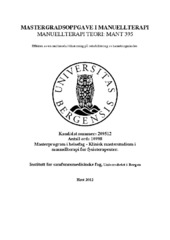| dc.contributor.author | Jokstad, Unni Heimli | en_US |
| dc.date.accessioned | 2014-07-15T08:32:40Z | |
| dc.date.available | 2014-07-15T08:32:40Z | |
| dc.date.issued | 2013-02-28 | eng |
| dc.date.submitted | 2013-02-28 | eng |
| dc.identifier.uri | https://hdl.handle.net/1956/8147 | |
| dc.description.abstract | Hamstrings muscle strain is the most common muscle injury in athletes in sports with rapid acceleration and maximal running speed. The starting point of this study is to demonstrate how the pelvis is often subject to large power transmission through sports activities and thus may predispose athletes for sacroiliac joints dysfunction. Purpose and Objectives: Does manipulation of SA Joint in combination with supervised exercise and cognitive approach effect on long-term hamstring injury among soccer players? Material and Methods: We included two athletes (n = 2), but one got sick during the study (n = 1). It was used a "Single-Subject Experimental Design" (ssed) with 2-week baseline, 7 weeks of intervention, and final measurements after 2 weeks. Interventions were, high velocity, low amplitude manipulation approaches (HVLA manipulation) / mobilization, with supervised exercise and cognitive approach. Participants logged adherence. Pain was recorded throughout the tests 11-point numeric rating scale (11 PNRS), Maitland's lumbar slumps. Local function was measured by the Active Straight Leg Raise (ASLR), Oswestry List function limitations, version 2 (ODI), Straight Leg Raising (SLR). Results: The study shows a tendency for manipulation in combination with supervised exercise and cognitive approach may be effective in the rehabilitation of long-term hamstring injury. The results after a 7-week intervention period showed that the subject had no pain, normal neural tension, normal local function and disability in daily life and about normal hamstring flexibility. Conclusion: The results of a ssed can not be generalized and range with only one test subject is very small. There is a need for RCTs in this area, including in relation to the classification of subgroups that can make lower back and pelvic girdle pain research more feasible. | en_US |
| dc.description.abstract | Hamstrings muskelstrekk er den mest vanlige muskelskaden blant idrettsutøvere innen idretter med hurtige akselerasjoner og maksimal løpsfart. Utgangspunktet med denne studien er å synliggjøre hvordan bekkenet ofte er utsatt for store kraftoverføringer gjennom idrettsaktiviteter og dermed kan predisponere utøverne for Iliosacralledds dysfunksjon. Hensikt og Problemstilling: Har manipulasjon av IS - leddet i kombinasjon med veiledet trening og kognitiv tilnærming effekt på langvarige hamstringsskader blant fotballspillere? Materiale og metode: Det ble inkludert to idrettsutøvere(n=2), men en gjennomførte(n=1). Det ble benyttet et " Single-Subject Experimental Design" (SSED) med 2 ukers baseline, 7 ukers intervensjon, og sluttmålinger etter 2 uker. Intervensjonene var, høy hastighet, lav amplitude manipulasjonsgrep (HVLA manipulasjon) / mobilisering, med veiledet trening og kognitiv tilnærming. Deltakeren loggførte egentrening. Smerte ble registrert gjennom testene 11-point numeric rating scale (11 PNRS), , Maitland's lumbal SLUMP. Lokal funksjon ble målt ved Active Straight Leg Raise (ASLR), Oswestry Liste for funksjonsbegrensninger, versjon 2 (ODI), Straight Leg Raising (SLR). Resultat: Studien viser en tendens til at manipulasjon i kombinasjon med veiledet trening og kognitiv tilnærming kan være effektivt i rehabilitering av langvarige hamstringsskader. Resultatene etter 7 ukers intervensjonsperiode viste at forsøkspersonen hadde ingen smerter, normal nevral spenning, normal lokal funksjon og funksjonsevne i dagliglivet og tilnærmet normal hamstringsfleksibilitet. Konklusjon: Resultatene av en SSED kan ikke generaliseres og utvalget med bare 1 forsøksperson er svært lite. Det er behov for RCT på området, også i forhold til klassifisering av subgrupper som kan gjøre korsrygg og bekkenplager mer forskbart. | en_US |
| dc.format.extent | 787915 bytes | eng |
| dc.format.mimetype | application/pdf | eng |
| dc.language.iso | nob | eng |
| dc.publisher | The University of Bergen | eng |
| dc.subject | Lårsmerter | eng |
| dc.subject | Idrettsutøvere | eng |
| dc.subject | Sportsskader | eng |
| dc.subject | Manuellterapi | eng |
| dc.subject | Hamstringsmuskler | eng |
| dc.subject | Hamstrings | eng |
| dc.subject.mesh | Musculoskeletal Manipulations | eng |
| dc.title | Effekten av en multimodal tilnærming på rehabilitering av hamstringsskader | en_US |
| dc.type | Master thesis | |
| dc.rights.holder | Copyright the author. All rights reserved | |
| dc.description.degree | Master i Klinisk masterstudium for fysioterapeuter i manuell terapi (MFMT | |
| dc.description.localcode | MAMD-MANT | |
| dc.description.localcode | MANT395 | |
| dc.subject.nus | 761901 | eng |
| fs.subjectcode | MANT395 | |
